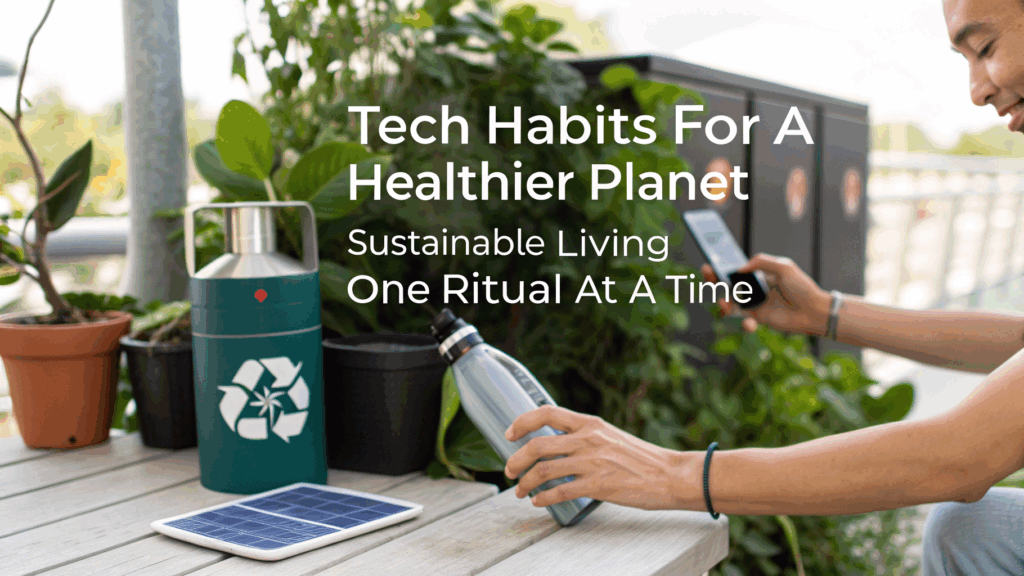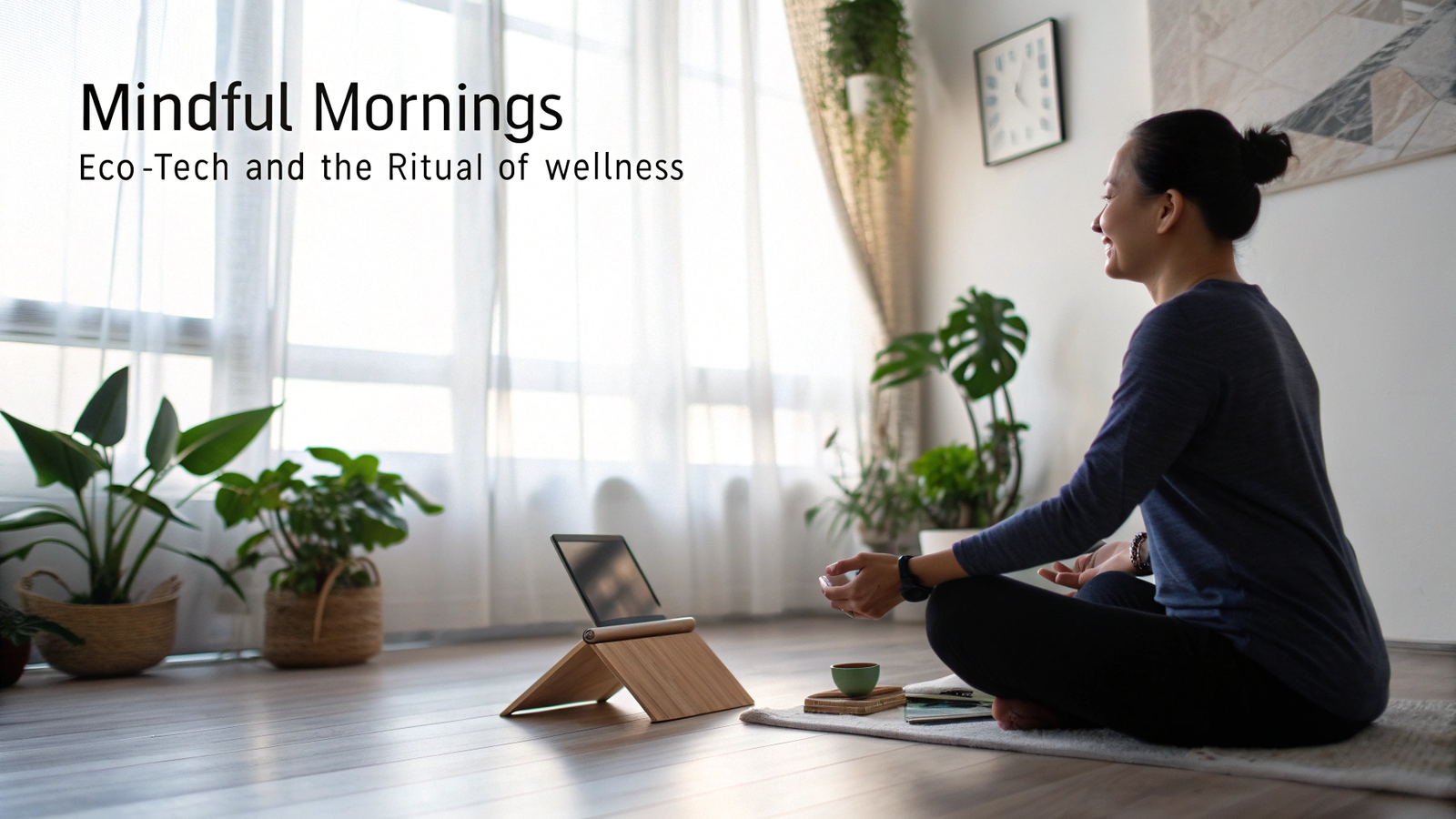Tech Habits for a Healthier Planet: Sustainable Living One Ritual at a Time
Introduction
In our hyperconnected world, tech is woven into nearly every aspect of life—from waking up and working to cooking and relaxing. Though convenient, it often comes with heavy environmental costs: soaring energy use, resource depletion, and electronic waste (e‑waste). Yet technology also offers powerful tools to foster eco-conscious living. When used mindfully, gadgets can automate sustainability, reveal habits, reduce waste, and extend product lifespans.
This article explores daily tech habits—simple but consistent routines powered by conscious technology—that empower low-impact living. Let’s dive into practical rituals you can adopt each day to support a healthier planet.

1. Make Devices Last Longer: Repair, Refurbish, Repurpose
Extend Lifespans with Care
Instead of chasing the latest phone or laptop, stretching the life of what you have dramatically reduces e‑waste. Learning basic repairs like battery or screen replacements, applying software updates, and avoiding unnecessary upgrades can make a huge difference Happiful+2Lenovo EDU Community+2BZBit+2.
Choose Refurbished Gear
Certified refurbished devices, like remanufactured laptops from Circular Computing, produce just 6.3% of the CO₂ compared to making a new one. Each refurbished laptop saves around 1,200 kg of resource extraction and preserves water and materials Wikipedia.
Donate and Repurpose
When you’re done with a gadget, donate it or upcycle it. For example, old smartphones can become IoT controllers or kitchen displays. E-waste recycling programs from retailers and cities help recover materials responsibly ChlorovilleIntelligent Living.
2. Optimize Energy Use: Smart Power, Smarter Habits
Enable Energy-Saving Settings
Reduce energy consumption by adjusting settings: lower screen brightness, activate sleep mode, and enable adaptive power saving. These small tweaks cut electricity use and extend battery life ChlorovilleHappiful.
Use Smart Thermostats and Plugs
Install smart thermostats (e.g. Ecobee or Nest) to automate heating and cooling, avoiding unnecessary energy use. Add smart plugs or power strips to cut off “vampire” standby power when devices aren’t in use Smartech DailyFortec USLifestyle → Sustainability Directory.
LED Lighting and Efficient Appliances
Switch to LED bulbs, turn off lights via motion sensors, and upgrade to energy-efficient appliances. Energy Star-rated devices and smart lighting systems reduce consumption while improving convenience BZBitTotal Computer TechnologyLifestyle → Sustainability Directory.
3. Shift to Renewable and Shared Power
Solar and Green Charging
Use solar-powered chargers or opt for gadgets with built-in solar cells. Even charging your phone near a sunlit window helps reduce grid dependency and carbon emissions BZBit+6Lenovo EDU Community+6Fortec US+6.
Leverage Public and Shared Tech
Embrace digital collaboration tools (Zoom, cloud docs) to reduce travel and paper use in your work. Where possible, borrow or rent devices instead of buying new—for example, when you need gear for a short-term project Intelligent Living+1Smartech Daily+1.
4. Practice Digital Minimalism and Mindfulness
Declutter Your Digital Life
Every email, uploaded file, and unused app has an environmental cost. Declutter your inbox, unsubscribe from unnecessary lists, and delete unused apps and files to lower your carbon footprint in data centers Happiful.
Focus Before Tech Check
Delay looking at your phone first thing in the morning. Starting your day with journaling, stretching, or meditation—not screen dings—fosters mental clarity, mindfulness, and less reactive consumption Lifestyle → Sustainability Directory.
5. Smart Homes, Smarter Living
Intelligent Home Automation
AI-powered homes anticipate routines and optimize ambiance—adjusting lighting, HVAC, air purifiers, and devices without manual input. These systems cut waste while improving comfort and focus Homes and GardensLifestyle → Sustainability Directory.
Real-Time Monitoring
Home energy monitors let you see how much power each device uses, how much CO₂ it emits, and when peak consumption occurs. Knowing this helps you make informed adjustments daily Smartech DailyLifestyle → Sustainability Directory.

6. Waste Reduction Through Circular Practice
Compostable and Refillable Products
In daily rituals like cleaning or skincare, opt for compostable materials or biodegradable accessories like bamboo toothbrushes and reusable notes. Incense made from temple-flower waste (as products like Nirmalaya offer) reduces indoor air pollution and supports circular economies Help Us Green+1Wikipedia+1.
Circular Brand Support
Choose brands committed to zero-waste design, take-back schemes, and sustainable packaging. Supporting such companies encourages industry-wide change.
7. Smart Mobility & Tech-Enabled Transport Efficiency
Use Public Transit & Apps
Use transit apps and bike-share platforms to avoid driving and reduce emissions. Tech-savvy commuters minimize fossil fuel use and support greener infrastructure Fortec US+1Total Computer Technology+1.
Remote Work & Virtual Connectivity
Where possible, work from home using video conferencing, cloud tools, and collaboration apps, reducing commuting-related pollution and energy use in office buildings Total Computer TechnologyIntelligent Living.
8. Habit Feedback and Gamification
Track Energy and Eco Progress
Apps and dashboards can show your cumulative energy savings, carbon avoided, or waste reduced—turning sustainable habits into tangible feedback loops.
In schools, gamified IoT-based tools have successfully driven energy-saving behaviors through competition and rewards—a method that could scale to homes and offices arxiv.org.
Educate and Advocate
Share your sustainable habits, e‑waste knowledge, and eco-tech tips with friends, family, or networks. Spread awareness through workshops or digital challenges—it amplifies impact zerowasteliving.netLenovo EDU Community.
9. Daily Ritual Framework: Morning to Night
Here’s how mindful tech habits map to a typical day:
- Morning: Delay checking phone; use a solar charger; power on smart display via voice; smart plug launches coffee maker.
- Workday: Use energy-efficient laptop; collaborate via cloud tools; minimize email clutter; travel via public transit.
- Home: Smart thermostat adjusts energy use; motion-based lighting saves power; compost kitchen scraps with biodegradable system; smart plug schedule turns off electronics.
- Evening: Use smart lighting to wind down; read on a repurposed tablet; turn off unnecessary power; store and recycle responsibly.

10. Challenges and Solutions
Accessibility and Cost
Smart gadgets and renewable setups sometimes carry higher upfront costs. Over time, energy savings and circular practices can offset expenses. Opt for incremental upgrades and certifications (e.g., Energy Star) HappifulLenovo EDU Community+2Smartech Daily+2Lifewire+2.
Infrastructure Gaps
Without local recycling, composting, or smart-grid support, impact may be limited. Advocating for municipal e‑waste centers and renewable energy programs is essential.
Behavior vs Technology
Tech needs behavior change to drive impact. Combining tech with education, apps like JouleBug or Oroeco, and real-time feedback helps build habits that stick zerowasteliving.netarxiv.org.
Conclusion
Sustainable tech habits offer a powerful path to eco-conscious living—without sacrificing comfort or convenience. From prolonging device lifespans and optimizing energy use to embracing renewable sources and mindful routines, each small change adds up.
By turning everyday tech behavior into low-impact rituals, we foster personal wellbeing and planetary stewardship. As individuals and communities adopt these habits, technology becomes less of a burden and more of a tool for positive environmental change.

